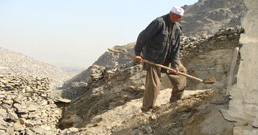The hills and mountains of
These areas, initially intended to act as green spaces within the city, soon became the locations for a booming population. Enayat Sani, an official with the
Following the end of the conflict in 2001 this population remained within the surrounding area of
Without the authority of an effective centralised government, field commanders from the conflict took advantage of the ambiguous political environment to seize this land and distribute it among their own supporters.
The problem was then further exacerbated after the fall of the Taliban in 2001 which subsequently led to the return of tens of thousands of migrants from the neighbouring countries.
Unable to cope with such an overwhelmingly rapid growth in the population of
This has resulted in the creation of unauthorised and unplanned residential areas without even the most basic practical provisions, such as an adequate sewage or water system. But with no other suitable accommodation available the government cannot provide alternatives for these residents.
According to Mohammed Azim Azimi, an expert in urban geography, the inhabitants also face the serious problem of earthquakes, as well as flooding during the rainy season. Last year seventy houses were severely damaged during the rains.
However, Enayat Sani believes that the current situation is only temporary and the shock of this massive boom is slowly being dealt with. Whether these new slums are temporary or not, concern has been raised about the preservation of historical monuments in the area.
As a former centre of the Buddhist religion and civilisation
He points, for example, at a two thousand year old wall by the
In the multimedia report on this page we hear from a number of the residents in the mountainsides around


